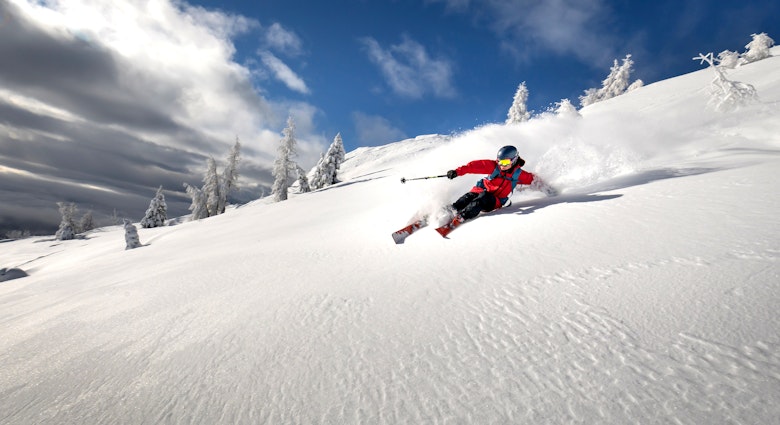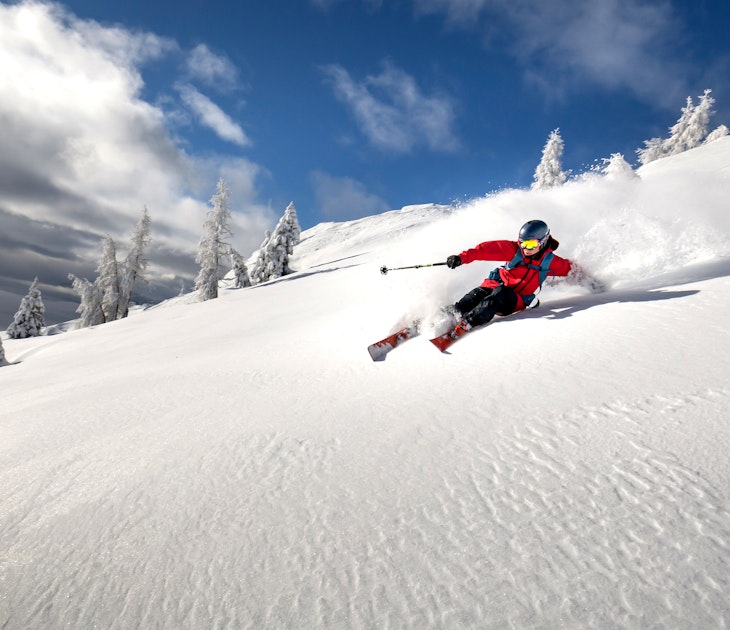

The ancient Irish game of hurling combines skill, athleticism and courage © Shutterstock / D. Ribeiro
Best moment of my (quasi-) sporting life? Squaring up to take a point at Dublin’s Croke Park with hurling legend Ollie Canning just a few paces away, urging me to take the shot.
It didn’t matter that the stands were empty, and this was just a bit of media day fun: I was about to knock the ball over the bar at this hallowed stadium, the largest in Ireland and the home of the Gaelic Athletic Association.
I took my stance and gripped and regripped the hurl. One last look at the posts and then I threw the ball into the air. I clipped it harmlessly about 20 yards in front of me, well shy of the posts.
- placement: fullWidth
- path: articles/in-content-top
- possible size: [970, 250], [970, 90], [728, 90], [300, 250], [320, 50], [1, 1],
- targeting:
{ "url": "get-into-hurling-ireland", "destination": "Ireland", "continent": "Europe", "country": "Ireland" }
“Better luck next time,” Ollie said with a smile. But there would be no next time – this was it. Still, best moment ever.

A (brief) hurling explainer: Things to know before you watch
At its best – that is, played by players who are good at it in front of large, appreciative crowds – hurling is like hockey on steroids. It’s a ball-and-stick game, but faster and much more physical.
3000 years of hurling
Hurling is one of the world’s oldest field games, having been played in one form or another for at least 3000 years. The first recorded mention of hurling dates to 1272 BC, when one of Ireland’s earliest inhabitants, the pre-Celtic Fir Bolg, took on the supernatural Tuatha dé Danann (“tribe of the Gods”) with hurls and won.
Cú Chulainn, the hero of one of the most important works of early Irish literature, the Táin Bo Cuailgne, was a renowned hurler who once killed a fierce guard dog by striking a sliotar down his throat from a great distance. Compensation for hurling injuries was written into the statutes of the Celts’ own legal system, known as Brehon Law.
The game was banned by the Normans in the 12th century but survived illegally nonetheless: one 17th-century account tells of ferocious hurling matches played on pitches that were 300 yards long. However, the game had different rules and even different names depending on which part of the country you were in. Clare and south Galway called it scuaib, while in Ulster it was known as camán, later Anglicised as ‘commons.’
The Gaelic Athletic Association
The current version of the game was codified following the establishment of the Gaelic Athletic Association (GAA) in 1884, a key pillar in the late 19th-century Gaelic Revival movement.
By encouraging the “preservation and cultivation of national pastimes,” the GAA sought to position traditional games like hurling (and the newer Gaelic football) as the essence of a new Irishness striving for independence. A common set of rules were introduced which haven’t changed much since then.
The rules of hurling
The tools of the game are the hurl or hurley (camán in Irish), an ash stick about a meter in length with a flattened, curved bas or ‘hand’ at the end that is used to pick up and strike the sliotar (pronounced ‘slittar’), a hard ball roughly the size of a baseball and also covered by two pieces of stitched leather. A well-struck sliotar can travel over 100m through the air at speeds of up to 150kph.
- placement: fullWidth
- path: articles/in-content-middle
- possible size: [970, 250], [970, 90], [728, 90], [300, 250], [320, 50], [1, 1],
- targeting:
{ "url": "get-into-hurling-ireland", "destination": "Ireland", "continent": "Europe", "country": "Ireland" }
The game is played by two teams of 15 players on a field that is up to 145m long and 90m wide. The aim is to get the sliotar between two long vertical posts joined by a horizontal bar. Goals (scored below the crossbar, protected by a goalkeeper) are worth three points, while a ball struck over the bar is worth one point. Scores are displayed thus: 1-4, meaning one goal and four points, for a total of seven points.

The details: getting organized
Hurling clubs are organized at the county level, with the best players from each vying to play for their county in the All-Ireland championships, which starts in April and pits counties against each other at a provincial, and then inter-provincial, level. The All-Ireland final sees the two best counties play for the Liam McCarthy Cup at a jam-packed Croke Park in late July.
The All-Ireland Championship’s poorer cousin is the Allianz Hurling League, which runs from February to April and is broken up into five divisions (with the best teams in Division 1 and the worst in Division 3B).
The most Irish of Irish games
Hurling is Ireland’s ‘official’ sport and most fans swell with pride when talking about the thrilling mix of speed and skill that makes it such an exciting game to watch.
Wrapped up in that pride is a sense that hurling represents a form of idealized Irishness, an ancient game unique to this island that combines skill, athleticism, courage (watch a player rise to grab a bare-handed catch while his opponent swings his hurl to field the same ball and you’ll see what we mean) and – most importantly – an undiluted feeling of community pride.
Like all Gaelic games, hurling is staunchly and stubbornly amateur. Nobody earns a salary from playing and there are no big-money transfers of the best players from one team to another. You play for your local club and, if you’re good enough, you get the chance to represent your county. Every kid who ever picks up a hurl dreams of representing their county in front of tens of thousands of their county brethren at Croke Park on All-Ireland Final day.
Hurling’s importance even reached the offices of UNESCO, who in 2018 recognized the game as a “unique and intangible cultural experience,” and inscribed it onto their cultural heritage list, along with pastimes like Holy Week in Guatemala and beekeeping in Slovenia.
Women’s hurling: Camogie
The women’s version of the game is called camogie. It is the same in all nearly all respects but is less physical, and players can score hand-passed goals, which are illegal in hurling. Games are shorter, and while hurling goalkeepers must wear a different color jersey than the rest of their teammates, camogie keepers don’t.
Camogie, which gets its name from camóg, the diminutive of camán, has been played since 1903. It was established by two Irish-language enthusiasts keen to make sure girls and women also rode the wave of cultural nationalism that shaped Irish identity in the decades leading up to independence. There are over 500 camogie clubs spread throughout the country, but the game is strongest in the same counties as hurling: notably Cork, Dublin, Kilkenny, and Tipperary.
- placement: native
- path: articles/in-content-native
- possible size: [f, l],
- targeting:
{ "url": "get-into-hurling-ireland", "destination": "Ireland", "continent": "Europe", "country": "Ireland" }
The women’s All-Ireland Final is usually held in late July or early August, on the Sunday between the hurling and football finals.

Where to watch hurling
Gaelic games are popular in every county in Ireland, but only a handful give pride of place to hurling. Kilkenny, Limerick, Waterford, Clare, and Tipperary are the hurling heartland, where Gaelic football is little more than an afterthought. A handful of other counties – Cork, Dublin, Galway, Offaly, and Wexford – put serious effort into both games.
Hurling’s ‘big three’ are Kilkenny, Tipperary, and Cork, who have between them won 94 championships out of the 135 contested since 1887. Kilkenny are the all-time title record-holders, with 36 All-Irelands to date; in 2023, Limerick are looking to win their fourth All-Ireland title in a row.
Tickets for county matches are easy to come by for the Allianz Hurling League and the early stages of the All-Ireland Championship. You can pick up tickets at the various grounds or through the counties’ own websites: Kilkenny play their home matches at Nolan Park in Kilkenny city; Cork at Páirc uí Chaoimh in Cork city; and Tipperary at Semple Stadium in Thurles.
Dublin’s home stadium is the 8,500-capacity Parnell Park in Donnycarney, on the north side of the city. It only moves to Croke Park if it manages to reach the latter stages of the All-Ireland Championship. Tickets are tougher to get for the really big games, but you can also try to buy them at most Centra or SuperValu convenience stores throughout the city center.

The details: how to nab tickets to a hurling match
You won’t pay any more than €20 for a ticket to a Division 1 match in the Allianz League or in the early stages of the championship; Division 3 hurling matches (where the standard of play is less than sterling) cost a flat €5. Under-16s get in free to all league matches. If you do manage to nab a ticket for the All-Ireland Final, expect to pay around €90 for a seat in any of the main stands at Croke Park.
Keep it going: give hurling a go yourself
Want to know what it’s actually like to hold a hurl and strike a sliotar? At Experience Gaelic Games you’ll get to meet members of a local Gaelic club and try your hand at hurling, as well as football and handball, a traditional Irish game very similar to the handball played in the US and elsewhere.
You also get a quick primer on the cultural significance of Gaelic sports in Ireland, but you can deepen that appreciation not too far away at the GAA Museum, in the bowels of the Cusack Stand at Croke Park. For an extra charge, you can join one of the twice-daily tours of the stadium itself, the fourth-largest in Europe; the skyline tour gives you a birds-eye view of the city from 17 floors up.
Take it home: bag some hurling swag
Besides the memory of watching the world’s fastest field game and pondering the question of how protective helmets were only made mandatory in 2010, you can pick up jerseys and hurling gear – including hurls and sliotars – at any major sporting shop like Elvery’s or Lifestyle Sports, which have branches throughout the country. If the shop doesn’t have your preferred jersey you will always find it on that county’s own GAA website.
- placement: fullWidth
- path: articles/bottom
- possible size: [970, 250], [970, 90], [728, 90], [300, 250], [320, 50], [1, 1],
- targeting:
{ "url": "get-into-hurling-ireland", "destination": "Ireland", "continent": "Europe", "country": "Ireland" }
Explore related stories








 SportsThese Liverpool fans flew to the wrong city and missed their team's Champions League win
SportsThese Liverpool fans flew to the wrong city and missed their team's Champions League winOct 25, 2019 • 2 min read

